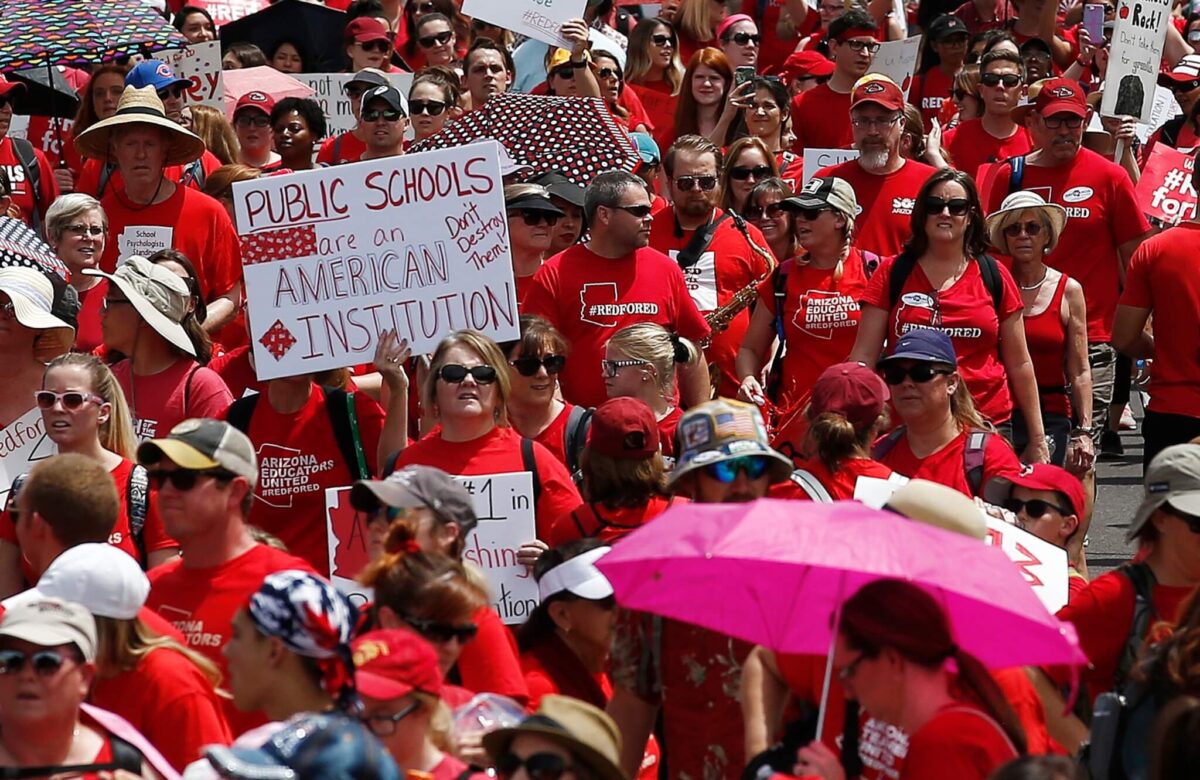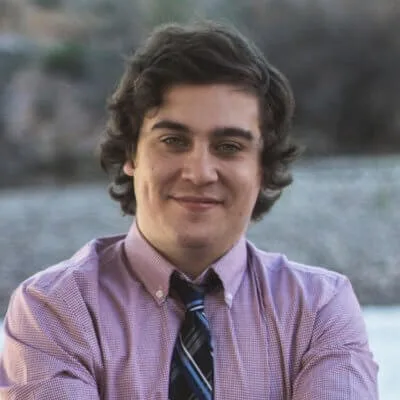
In this April 26, 2018, file photo, thousands march to the Arizona Capitol for higher teacher pay and public school funding on the first day of a state-wide teachers strike in Phoenix. (AP Photo/Ross D. Franklin)
💬 “We are more than committed to flipping this Legislature to a pro-public school legislator Legislature,” — Marisol Garcia, Arizona Education Association president
Rosana Zarza-Canova is a public school teacher in southern Arizona. As an English language development teacher, she needs to write things out for her students fairly often—but she almost didn’t get funding for those supplies.
“I had to pull teeth to get whiteboard markers and paper,” Zarza-Canova said. “Teachers end up buying all of these basic supplies on their own.”
In 2022, Arizona had the highest teacher turnover rate in the US—roughly 25%, according to a study from the Learning Policy Institute—and the state is ranked No. 32 in the nation for teacher pay.
“In general, teachers in the US, they’re just not appreciated,” Zarza-Canova said.
Marisol Garcia, president of the Arizona Education Association—Arizona’s labor union for public school employees—said pay is a huge reason why so many teachers are leaving public education.
“We are legitimately concerned that people are not going to return or we’re not going to be able to get folks into the profession from college,” Garcia said. “If I am graduating with a [bachelor’s], I am going to walk into a position that’s going to maybe be about $43,000.”
Per-pupil funding is also at play here. According to the US Census Bureau, Arizona is third-lowest in the nation for per-pupil spending.
This can partially be attributed to Arizona’s education funding formula, which predates the existence of charter schools and our universal voucher program. This has resulted in the same amount of funds spread to more schools, instead of increasing the education budget to meet demand.
The state provides schools with a base amount depending on the number of students enrolled, the number of students who require specialized attention—such as pupils with disabilities or English language learners—and the grade level of the student body.
School districts can issue bonds to supply additional funds, which must be approved by voters living within district boundaries. The amount of funding achieved through bonds varies widely, and usually ends up favoring wealthier areas.
Arizona also has a law that caps education spending for public schools—often shorting schools over $1 billion in required funds—although this is routinely lifted by the state Legislature.
Garcia pointed to another issue separating the haves from the have-nots—the Republican Legislature has been quick to create tax breaks for big corporations.
“It’s the cutting of taxes for the rich, and carve outs for industries coming to the state,” Garcia said. “Everyone celebrates having all these companies coming here, but they’re coming here and they’re being offered incredible tax rates and tax cuts, and that’s how you pay for public schools.”
Garcia said the Arizona Education Association used to have great conversations with Republicans in rural districts, because often those districts were the largest employers in small towns. But once the universal voucher program became mainstream for Arizona conservatives, those talks became less public and less frequent.
“It’s so difficult because a lot of these Republicans in rural areas who we think that we could really break bread with and do break bread with behind closed doors are running in primaries with people who are adamant that vouchers should be the entire system,” Garcia said.
EXPLAINED: How latest school voucher expansion caters to wealthy at students’ expense
With increased funding can come better teacher salaries, better school infrastructure, more supplies, and smaller class sizes. Unfortunately for public educators, it appears that only Democrats, the minority in both chambers of the state Legislature, are interested in prioritizing public education and reigning in the state’s universal voucher program.
“The educational waivers that parents can get to homeschool their students or send them to private schools—that’s taking money away from public schools,” Zarza-Canova said.
Gov. Katie Hobbs, a Democrat, announced a plan in January to increase accountability and transparency in the universal voucher program, which is projected to cost the state upwards of $900 million.
The explosive cost has been attributed to two factors: first, roughly 50,000 students who never attended public school—such as private or homeschool students—now have their education subsidized through vouchers, thanks to the program’s universal expansion in 2022.
And second, Republicans in the Legislature changed the voucher funding formula: originally, it covered 90% of what it cost for a student to attend public school. Now, vouchers cover 90% of the cost to attend a charter school. Since charter schools are more expensive than public schools, students using vouchers to attend them are draining the fund at a faster rate than their peers in public schools.
Despite all the forces working against them, both Garcia and Zarza-Canova touted the importance of teachers working in public education.
“It takes commitment and it takes a lot of patience, a lot of patience,” Zarza-Canova said. “There’s a lot to teaching. I think a lot of people don’t understand how complex it is.”
Arizonans hoping to see a change in public school funding have the opportunity this Nov. 5, when experts predict political majorities in both the state House and Senate may be vulnerable for the first time in decades.
Support Our Cause
Thank you for taking the time to read our work. Before you go, we hope you'll consider supporting our values-driven journalism, which has always strived to make clear what's really at stake for Arizonans and our future.
Since day one, our goal here at The Copper Courier has always been to empower people across the state with fact-based news and information. We believe that when people are armed with knowledge about what's happening in their local, state, and federal governments—including who is working on their behalf and who is actively trying to block efforts aimed at improving the daily lives of Arizona families—they will be inspired to become civically engaged.


At Arizona civics camp, Hobbs urges young students to take initiative, seek mentors
PHOENIX – Gov. Katie Hobbs advised students visiting Arizona from around the country to seek out mentors and grasp opportunities as they come along....

Arizona Gov. Katie Hobbs vetoes bill banning teaching antisemitism, calls it an attack on educators
Arizona Gov. Katie Hobbs has vetoed a proposal that would have banned teaching antisemitism at the state’s public K-12 schools, universities and...

Unleash your creativity at NAU’s Young Authors Camp
Students can get creative with NAU’s Young Authors Camp, July 7-11. Plus, scholarships are available via Northern Arizona Book Festival. Aspiring...

Bill that would allow parents to sue teachers over ‘antisemitic conduct’ moves to governor’s desk
PHOENIX — The Arizona House of Representatives passed a final version of HB 2867, the Antisemitism in Education Act, on Wednesday, the last hurdle...





